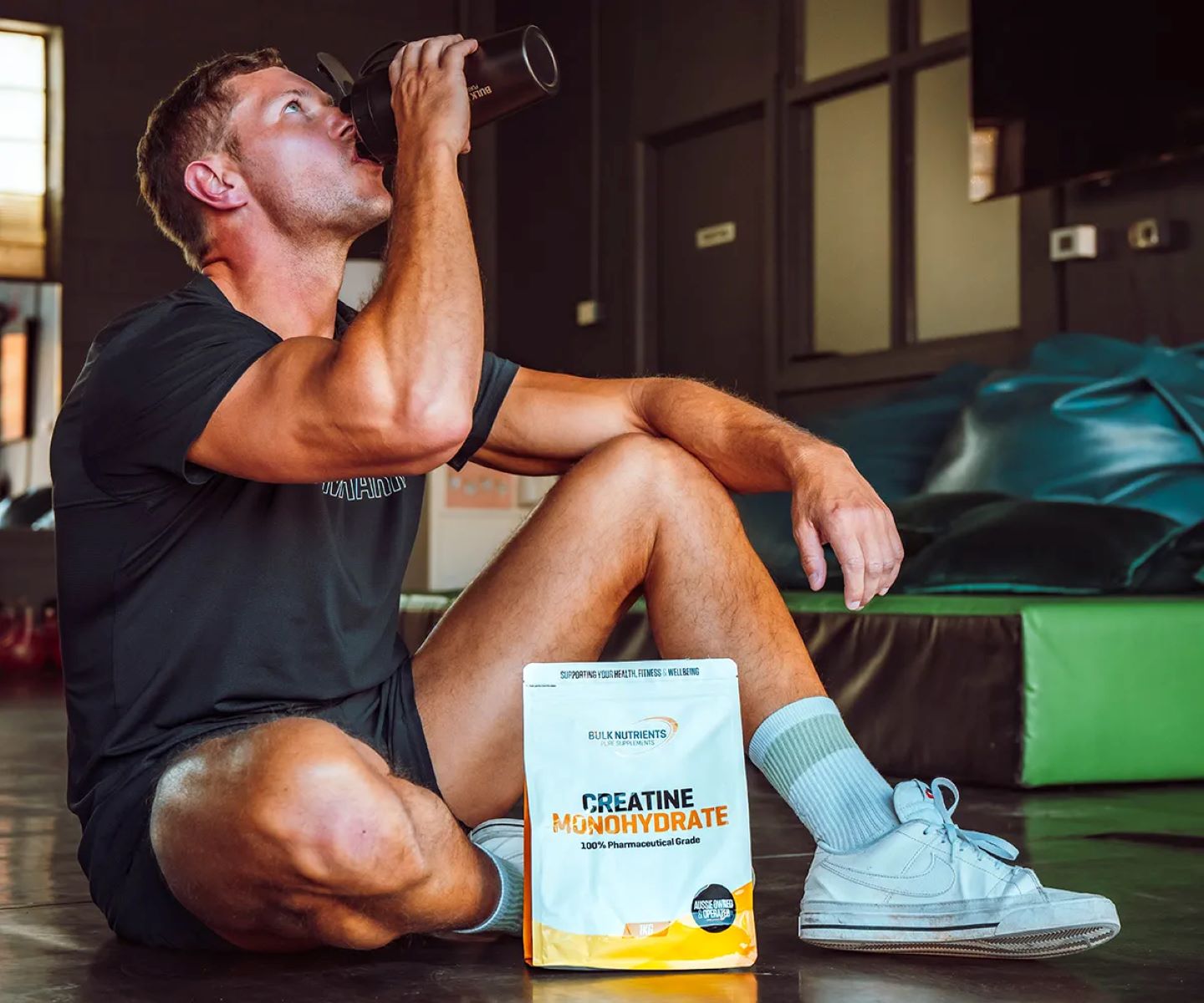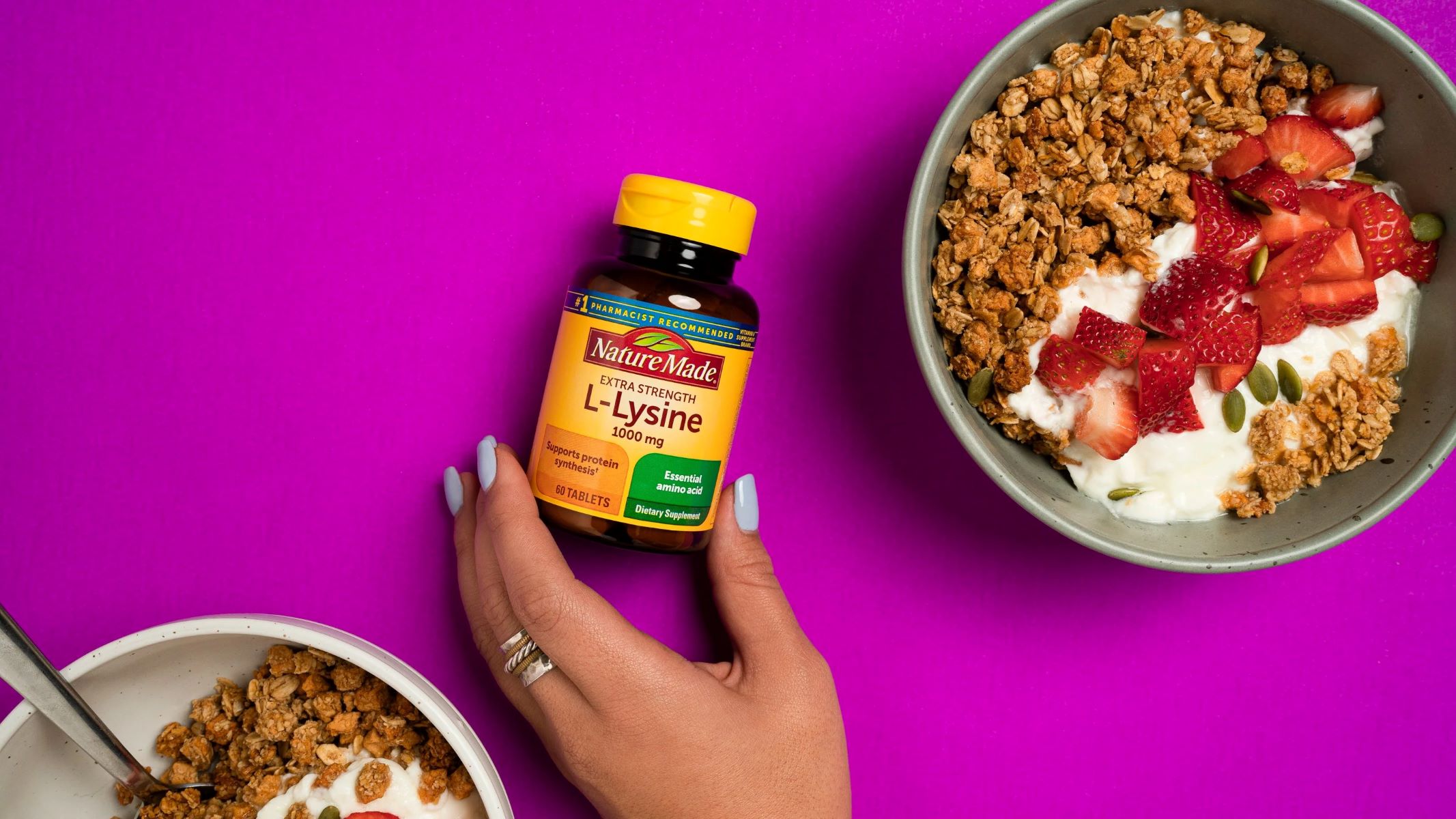Home>Misc>Featured>How To Improve The Athletic Performance By Increasing Muscle


Featured
How To Improve The Athletic Performance By Increasing Muscle
Modified: March 1, 2024
Want to improve your athletic performance? Discover the key to enhancing your muscle growth and achieve your fitness goals with our featured tips.
Introduction
Achieving peak athletic performance requires athletes to constantly push their limits. While factors like skill, technique, and mental resilience play a crucial role, the foundation of athletic performance lies in the body’s physical capabilities, particularly muscle strength and endurance. Building and increasing muscle mass is a key component in enhancing athletic performance and can lead to improved speed, power, agility, and overall performance in sports.
However, achieving and maintaining optimal muscle growth is a complex process that requires a combination of proper nutrition, targeted training, and adequate recovery. In this article, we will explore the importance of muscle for athletic performance and delve into the strategies that can help athletes effectively increase muscle mass.
Understanding the role of muscle in athletic performance is essential. Muscles are responsible for generating force and power during physical activity. Having a well-developed musculature allows athletes to produce more force, move more efficiently, and withstand higher levels of stress and fatigue.
Furthermore, increased muscle mass can enhance an athlete’s ability to perform explosive movements, such as sprinting, jumping, or throwing, which are often essential in various sports. In addition, having a greater muscle mass can also help protect joints and prevent injuries, as strong muscles can absorb impact and provide stability.
Now that we understand the importance of muscle for athletic performance, let’s dive into the key factors that contribute to muscle growth and how athletes can effectively optimize their muscle-building potential.
Importance of Muscle for Athletic Performance
When it comes to athletic performance, having strong and well-developed muscles is crucial. Muscles are responsible for generating force and power, which are essential for movements like running, jumping, and throwing. Here are some key reasons why muscle is important for athletic performance:
- Increased strength: Having larger and stronger muscles allows athletes to exert more force and generate greater power. This can lead to improvements in speed, acceleration, and overall performance.
- Improved endurance: Muscles play a vital role in endurance activities by providing the necessary energy and oxygen to sustain physical effort over an extended period of time. Well-trained muscles have higher endurance capacity, allowing athletes to perform at a high level for longer durations.
- Enhanced agility and explosiveness: Strong muscles enable athletes to change direction, react quickly, and produce explosive movements. This is particularly important in sports that require rapid changes in direction, such as basketball, soccer, or tennis.
- Reduced risk of injury: Well-developed muscles provide stability and support to the joints, helping to absorb impact and reduce the risk of injury. Strong muscles can also help athletes maintain proper form and technique, which further minimizes the risk of musculoskeletal injuries.
- Optimal body composition: Increasing muscle mass can help athletes achieve a favorable body composition by reducing body fat and increasing lean muscle mass. This not only improves overall aesthetics but also enhances athletic performance by improving strength-to-weight ratio.
It is important to note that muscle is not solely about size and appearance. Building muscle goes beyond aesthetics and holds significant implications for an athlete’s overall performance and long-term athletic development.
Now that we understand the importance of muscle for athletic performance, let’s explore the factors that contribute to muscle growth and how athletes can effectively increase their muscle mass and strength.
Understanding Muscle Growth
Before delving into strategies for increasing muscle mass, it’s important to understand how muscle growth occurs. Muscle growth, also known as muscle hypertrophy, is a complex process that involves the enlargement of individual muscle fibers.
When we engage in resistance training, such as weightlifting or bodyweight exercises, our muscles undergo microscopic damage. This damage stimulates a process called muscle protein synthesis, where new proteins are synthesized to repair and strengthen the damaged muscle fibers. Over time, with consistent training and proper recovery, these repaired muscle fibers become larger and stronger, resulting in increased muscle mass.
There are two primary types of muscle hypertrophy: sarcoplasmic hypertrophy and myofibrillar hypertrophy. Sarcoplasmic hypertrophy involves an increase in the size of the sarcoplasm, the fluid and energy stores within the muscle. This type of hypertrophy primarily contributes to muscle volume and visual appearance. On the other hand, myofibrillar hypertrophy involves an increase in the number and size of myofibrils, the contractile units of muscle. This type of hypertrophy is associated with an improvement in overall muscle strength and power.
In order to stimulate muscle growth, it’s important to engage in resistance training that targets specific muscle groups. This can be achieved through a variety of exercises, including compound exercises that involve multiple muscle groups, such as squats, deadlifts, and bench presses, as well as isolation exercises that target individual muscles, such as bicep curls or calf raises.
It’s worth mentioning that genetics also play a role in muscle growth. Some individuals naturally have a higher propensity for muscle growth, while others may find it more challenging to achieve significant gains. However, with the right training and nutrition strategies, anyone can make progress and improve their muscle mass.
Now that we have a basic understanding of muscle growth, let’s explore the role of nutrition in supporting muscle development and increasing muscle mass.
Nutrition for Muscle Gain
Proper nutrition is essential for supporting muscle growth and maximizing muscle gain. In order to build and repair muscle tissue, athletes need to consume a well-balanced diet that provides the necessary macronutrients and micronutrients for muscle development. Here are some key nutrition tips for increasing muscle mass:
- Protein intake: Protein is the building block of muscle tissue and is essential for muscle repair and growth. Aim to consume an adequate amount of protein from high-quality sources such as lean meats, poultry, fish, eggs, dairy products, and plant-based protein sources like beans, lentils, tofu, and tempeh. A general guideline is to consume around 1.2-2 grams of protein per kilogram of body weight per day.
- Caloric surplus: In order to support muscle growth, athletes need to consume more calories than they expend. This is known as being in a caloric surplus. However, it’s important to consume quality calories from nutrient-dense foods rather than relying on processed or unhealthy foods. Aim to consume a balanced diet that includes a variety of whole grains, fruits, vegetables, lean proteins, and healthy fats.
- Carbohydrates and fats: Carbohydrates provide the body with energy for intense workouts and help replenish muscle glycogen stores. Include complex carbohydrates such as whole grains, fruits, and vegetables in your diet. Healthy fats, like those found in avocados, nuts, seeds, and olive oil, are important for hormone production and overall health.
- Hydration: Staying properly hydrated is crucial for optimal muscle function and recovery. Drink enough water throughout the day and consider consuming electrolyte-rich drinks during intense training sessions or prolonged physical activity.
In addition to meeting macronutrient needs, it’s important to focus on consuming nutrients that support muscle recovery and reduce inflammation. Antioxidant-rich fruits and vegetables, Omega-3 fatty acids from sources like fatty fish, and foods high in vitamins and minerals such as iron, magnesium, and zinc are beneficial for muscle health.
Remember, nutrition is not a one-size-fits-all approach. It’s important to listen to your body and adjust your calorie and nutrient intake based on your individual goals, body composition, and training intensity.
Now that we have covered the basics of nutrition for muscle gain, let’s discuss the importance of resistance training in building muscle mass.
Protein Intake
When it comes to building muscle, protein plays a critical role. Protein is made up of amino acids, which are the building blocks of muscle tissue. Consuming an adequate amount of protein is essential for muscle repair, growth, and recovery. Here are some key considerations for protein intake:
- Optimal protein sources: Include high-quality protein sources in your diet, such as lean meats, poultry, fish, eggs, dairy products, and plant-based protein sources like beans, lentils, tofu, and tempeh. These protein sources provide a complete amino acid profile that is necessary for muscle growth.
- Daily protein requirement: The recommended protein intake for athletes looking to build muscle ranges from 1.2 to 2 grams of protein per kilogram of body weight per day. This range ensures that you are providing your body with enough protein to support muscle growth and repair.
- Timing of protein consumption: Distribute your protein intake evenly throughout the day, rather than consuming it all in one sitting. This helps optimize muscle protein synthesis and allows for a steady supply of amino acids to support muscle repair and growth.
- Pre and post-workout protein: Consuming a protein-rich meal or snack within an hour before and after your workouts can help maximize muscle protein synthesis. This can be in the form of a protein shake, Greek yogurt, or a protein-rich meal containing lean protein sources and carbohydrates.
- Protein supplementation: In some cases, athletes may find it challenging to meet their protein requirements solely through whole foods. In such cases, protein supplements like whey protein, casein protein, or plant-based protein powders can be a convenient and effective way to increase protein intake.
It’s important to note that while protein is essential for muscle growth, it’s not the only macronutrient that plays a role. A well-balanced diet that includes carbohydrates and healthy fats is necessary to provide the energy and nutrients required for optimal muscle growth and overall performance.
Remember, individual protein needs may vary based on factors such as training intensity, body weight, and goals. Consulting with a registered dietitian or sports nutritionist can help determine your specific protein needs and develop a personalized nutrition plan to support your muscle-building goals.
Now that we have covered the importance of protein in muscle gain, let’s explore the concept of being in a caloric surplus for muscle growth.
Caloric Surplus
In order to build muscle mass, it’s important to consume a sufficient amount of calories. This means being in a caloric surplus, where you are consuming more calories than you burn throughout the day. A caloric surplus supplies your body with the energy it needs to support muscle growth and repair. Here are some key considerations for creating a caloric surplus:
- Determine your calorie needs: Start by calculating your total daily energy expenditure (TDEE), which is an estimate of the number of calories your body needs to maintain its current weight. You can find TDEE calculators online or consult with a registered dietitian for a more accurate assessment.
- Increase calorie intake gradually: It’s best to gradually increase your calorie intake by around 200-500 calories per day to avoid excessive weight gain. This allows your body to adjust to the surplus and minimize the risk of unwanted fat gain.
- Focus on nutrient-dense foods: While in a caloric surplus, it’s still important to prioritize nutrient-dense foods that provide the necessary macronutrients and micronutrients for muscle growth. Include lean proteins, complex carbohydrates, healthy fats, fruits, and vegetables in your diet.
- Monitor progress and adjust: Track your body weight, body composition, and performance in the gym regularly. If you are not seeing the desired muscle growth, you may need to increase your calorie intake further. On the other hand, if you notice excessive weight gain or an increase in body fat, you may need to reduce your calorie surplus slightly.
It’s important to note that while being in a caloric surplus is necessary for muscle growth, it’s crucial to maintain a balanced approach. Consuming an excessive surplus of calories can lead to unwanted fat gain, which may hinder athletic performance. Aim to strike a balance by gradually increasing your calorie intake and monitoring your progress closely.
Remember, the exact calorie surplus needed will vary depending on factors such as individual metabolism, training intensity, and goals. Working with a registered dietitian or certified nutritionist can help determine your specific calorie needs and develop an appropriate nutrition plan for muscle gain.
Now that we understand the importance of being in a caloric surplus, let’s discuss the role of carbohydrates and fats in supporting muscle growth.
Carbohydrates and Fats
Carbohydrates and fats are vital macronutrients that play significant roles in supporting muscle growth and providing the energy required for optimal athletic performance. Here’s a closer look at the importance of carbohydrates and fats in your muscle-building nutrition plan:
- Carbohydrates: Carbohydrates are the body’s primary source of energy. They provide the fuel needed for intense workouts and help replenish glycogen stores in the muscles. Including complex carbohydrates such as whole grains, fruits, and vegetables in your diet ensures a steady supply of energy throughout the day. Prioritize whole, unprocessed carbohydrates over refined and sugary options.
- Fats: Healthy fats are essential for hormone production, nutrient absorption, and overall health. They provide a source of energy and help regulate inflammation in the body. Opt for sources of healthy fats such as avocados, nuts, seeds, and olive oil. Including a moderate amount of dietary fat in your muscle-building diet can support overall nutrition and provide satiety.
- Timing of carbohydrates and fats: Distribute your carbohydrate and fat intake throughout the day to ensure energy availability during workouts and sufficient recovery. Consuming a balanced meal containing carbohydrates, fats, and proteins a few hours before exercise can provide sustained energy. After workouts, prioritize consuming carbohydrates and protein to replenish glycogen stores and promote muscle repair.
- Monitor nutrient balance: While it’s important to include carbohydrates and fats in your diet, it’s crucial to maintain a balance and avoid excessive consumption. Too many carbohydrates or unhealthy fats can lead to unwanted weight gain or an imbalance in nutrient intake. Tracking your macronutrient intake and adjusting it based on your body’s needs and goals is essential.
Remember, each person’s carbohydrate and fat requirements may vary based on factors such as training intensity, body composition goals, and individual preferences. Experimenting with different ratios and listening to your body’s response can help determine the optimal balance for you.
Working with a registered dietitian or sports nutritionist can provide personalized guidance on carbohydrate and fat intake, ensuring that your nutrition plan supports muscle growth while also meeting your overall health and performance needs.
Now that we’ve covered the role of carbohydrates and fats, let’s move on to discussing the importance of hydration for muscle growth and overall athletic performance.
Hydration
Staying adequately hydrated is crucial for overall health and plays a vital role in supporting muscle growth and athletic performance. Water is involved in numerous physiological processes, including nutrient delivery, muscle function, temperature regulation, and waste removal. Here are some key considerations for hydration:
- Water intake: Aim to drink enough water throughout the day to maintain proper hydration. The general recommendation is to consume at least 8 cups (64 ounces) of water per day, but individual needs may vary based on factors such as body size, activity level, and climate.
- Pre-workout hydration: Make sure to start your workouts well-hydrated by drinking water in the hours leading up to exercise. This helps to ensure optimal fluid balance and performance during your workouts.
- During-workout hydration: During intense exercise, especially in hot environments, your body loses significant amounts of water through sweat. To maintain hydration, drink fluids regularly during exercise. Water is typically sufficient for most workouts, but for longer or more intense sessions, consider consuming electrolyte-rich sports drinks to replenish sodium and other essential electrolytes lost through sweat.
- Post-workout hydration: Rehydrating after exercise is crucial for recovery. Drink water or a combination of water and electrolyte-rich fluids to replenish fluids and restore electrolyte balance.
- Monitoring hydration: Pay attention to signs of dehydration such as dark urine, dizziness, fatigue, and dry mouth. These can indicate that you need to increase your fluid intake. Additionally, monitoring your body weight before and after exercise can help gauge water loss and help determine your hydration needs.
Proper hydration not only supports muscle growth but also helps optimize digestion, nutrient absorption, and overall performance. It’s important to develop a habit of regularly hydrating throughout the day, not just during exercise.
Remember that individual hydration needs may vary depending on factors such as body size, activity level, and environmental conditions. It’s always a good idea to listen to your body and adjust your fluid intake accordingly. Consulting with a registered dietitian or sports nutritionist can provide personalized recommendations based on your specific needs and goals.
Now that we understand the importance of hydration, let’s move on to discussing the role of resistance training in building muscle mass.
Resistance Training
Resistance training, also known as strength training or weightlifting, is a fundamental component of muscle growth. It involves the use of external resistance, such as weights, resistance bands, or bodyweight, to stimulate muscle fibers and promote muscle hypertrophy. Here are some key considerations for incorporating resistance training into your muscle-building regimen:
- Compound exercises: Compound exercises engage multiple muscle groups and joints simultaneously, allowing you to lift heavier weights and work multiple muscles in one movement. Examples of compound exercises include squats, deadlifts, bench presses, and pull-ups. These exercises provide a solid foundation for building overall strength and muscle mass.
- Progressive overload: Progressive overload is the concept of continually challenging your muscles by gradually increasing the weight, reps, or intensity of your workouts over time. This progressive stimulation is necessary to trigger muscle growth. Keep a record of your workouts, increase the resistance gradually, and strive for gradual and consistent progress in your training sessions.
- Variety in exercises: While compound exercises should form the core of your training, incorporating a variety of exercises can help target different muscle groups and avoid plateaus. Include isolation exercises such as bicep curls, tricep extensions, and calf raises to specifically target individual muscles.
- Proper form and technique: Using correct form and technique is crucial for maximizing muscle engagement and preventing injuries. Always prioritize quality over quantity and focus on performing exercises with proper technique. If you’re unsure about the correct form, consider working with a qualified strength and conditioning coach or a personal trainer.
- Training frequency: Aim to train each muscle group 2-3 times per week to allow sufficient recovery and growth. Adequate rest between workouts is crucial, as muscles repair and grow during periods of rest.
Remember, consistency is key when it comes to resistance training. Regularly challenging your muscles and providing them with adequate rest and recovery time is essential for promoting muscle growth. It’s also important to listen to your body and adjust your training plan based on your individual needs and recovery capacity.
Additionally, including flexibility and mobility exercises in your training routine can help improve joint range of motion, prevent muscle imbalances, and reduce the risk of injury.
Now that we understand the importance of resistance training for muscle growth, let’s explore the role of rest and recovery in optimizing muscle development.
Compound Exercises
Compound exercises are an essential component of any muscle-building program. These exercises involve multiple muscle groups and joints working together, allowing you to lift heavier weights and stimulate overall muscle growth. Here’s why compound exercises should be a focus in your training routine:
- Muscle recruitment: Compound exercises recruit several muscle groups simultaneously, engaging both primary and secondary muscles. This leads to more efficient and effective muscle activation compared to isolation exercises that target only one muscle group at a time.
- Functional movements: Compound exercises mimic real-life movements and activities, making them highly practical and applicable to daily activities, sports, and overall athleticism. By training multiple muscles together, you develop strength and coordination that can transfer to various physical tasks.
- Higher calorie burn: Due to the involvement of multiple muscle groups, compound exercises require more energy and lead to a greater calorie burn during and after the workout. This can contribute to overall fat loss and improved body composition.
- Time efficiency: Incorporating compound exercises into your workouts allows you to target multiple muscle groups in a shorter amount of time. This is beneficial for individuals with limited time for training or those looking to maximize their efficiency in the gym.
- Increased hormonal response: Compound exercises elicit a greater release of anabolic hormones such as testosterone and growth hormone, which are crucial for muscle growth and repair. This hormonal response can further enhance muscle development and improve overall strength and power.
Examples of compound exercises include squats, deadlifts, bench presses, pull-ups, lunges, and overhead presses. These exercises require multiple joints and recruit large muscle groups, such as the legs, back, chest, and shoulders.
When incorporating compound exercises into your workout routine, it’s important to prioritize proper form and technique. Focus on maintaining a stable core, using a full range of motion, and gradually increasing the weight as you progress. If you’re new to these exercises, consider seeking guidance from a qualified strength and conditioning professional or a personal trainer to ensure proper execution and reduce the risk of injury.
Remember, while compound exercises are valuable, it’s also beneficial to incorporate some isolation exercises to target specific muscle groups and address individual muscle imbalances or weaknesses.
Now that we understand the importance of compound exercises, let’s explore the concept of progressive overload for muscle growth.
Progressive Overload
Progressive overload is a fundamental principle of muscle growth and strength development. It involves gradually increasing the demands placed on your muscles to stimulate continual adaptations and progress. Here’s why progressive overload is crucial for maximizing muscle growth:
- Muscle adaptation: Our bodies adapt to the stress placed upon them, including resistance training. When you consistently challenge your muscles with increased intensity, such as lifting heavier weights or performing more repetitions, your body responds by making physiological changes, including muscle growth and increased strength.
- Mechanical tension: Progressive overload allows you to continually increase the mechanical tension placed on your muscles. This tension, created by lifting heavier weights, initiating controlled eccentric contractions, and focusing on the quality of your reps, is a key stimulus for muscle growth.
- Neuromuscular adaptation: Progressive overload not only triggers muscle growth but also improves the neuromuscular connection. As you continually challenge your muscles, your nervous system becomes more efficient at recruiting and activating muscle fibers, leading to increased strength and enhanced muscle control.
- Preventing plateaus: Without progressive overload, your muscles may adapt and reach a plateau, where they no longer experience significant growth or strength gains. Continually increasing the demands placed on your muscles ensures ongoing adaptations, preventing plateaus and promoting continuous progress.
To apply the principle of progressive overload, consider the following strategies:
- Increase resistance: Gradually increase the weight you lift as you become stronger. Aim to add small increments of weight, such as 5-10% at a time, to maintain proper form and minimize the risk of injury.
- Progressive repetitions: Gradually increase the number of repetitions you perform with a certain weight. Once you can perform a set number of repetitions with good form, challenge yourself by adding one more repetition in subsequent workouts.
- Manipulate sets and rest periods: Adjust the number of sets and rest periods in your workouts to challenge your muscles in different ways. For example, you can increase the number of sets or decrease rest periods to increase the intensity and difficulty of your training sessions.
- Vary exercise intensity: Incorporate techniques like drop sets, supersets, and pyramid sets to increase the intensity of your workouts and provide a new stimulus to your muscles.
Remember, progressive overload is a gradual process, and it’s important to listen to your body and progress at a sustainable pace. Regularly assess your performance, track your progress, and make adjustments to your training program to ensure ongoing growth and adaptation.
Now that we understand the concept of progressive overload, let’s move on to discussing the importance of recovery and rest for maximizing muscle development.
Recovery and Rest
Recovery and rest are often overlooked aspects of muscle development, but they are crucial for optimizing gains and preventing overtraining. Adequate recovery allows your muscles to repair, rebuild, and adapt to the training stressors placed upon them. Here’s why prioritizing recovery and rest is essential for maximizing muscle development:
- Muscle repair and growth: When you engage in resistance training, your muscles experience micro-tears. During the recovery process, these muscles repair and rebuild, resulting in increased muscle size and strength. Giving your muscles sufficient time to recover ensures optimal adaptations from your training.
- Prevention of overtraining: Overtraining occurs when you do not provide enough time for your muscles to recover between workouts. This can lead to decreased performance, increased risk of injuries, and hindered muscle growth. Prioritizing rest and recovery helps prevent overtraining and allows your body to perform at its best.
- Hormonal balance: Rest and recovery play a role in maintaining hormonal balance, including the production of testosterone and growth hormone, which are essential for muscle growth and repair. Sufficient rest helps ensure optimal hormone production and supports muscle development.
- Injury prevention: Giving your muscles time to rest and recover helps prevent overuse injuries that can occur from excessive training. It allows for the repair of damaged tissues, reduces inflammation, and improves overall joint health and mobility.
- Quality of training sessions: Rest is crucial for ensuring that you can perform at your best during training sessions. Well-rested muscles have greater energy and endurance, allowing you to lift heavier weights, push harder, and maintain proper form throughout your workouts.
It’s important to incorporate adequate rest and recovery into your training routine. Here are some strategies to optimize your recovery:
- Active recovery: Engage in low-intensity activities, such as walking, swimming, or cycling, on rest days. This promotes blood flow, reduces muscle soreness, and aids in muscle recovery.
- Sleep: Prioritize quality sleep as it is essential for recovery and overall health. Aim for 7-9 hours of uninterrupted sleep each night to support muscle repair, hormone regulation, and cognitive function.
- Stretching and mobility exercises: Incorporate stretching and mobility exercises into your routine to improve flexibility, reduce muscle tightness, and enhance joint range of motion.
- Listen to your body: Pay attention to signs of fatigue, muscle soreness, or decreased performance. Adjust your training intensity, volume, or frequency accordingly to allow for proper recovery.
Remember, rest and recovery should be individualized based on factors such as training intensity, age, and overall health. It’s important to find a balance between challenging your muscles and allowing them time to recover in order to optimize muscle growth and performance.
Now that we understand the importance of recovery and rest, let’s discuss the potential benefits of incorporating supplements into your muscle-building plan.
Sleep
Sleep is a crucial factor in optimizing muscle growth and overall athletic performance. It is during sleep that our bodies repair and regenerate, and this includes the repair and rebuilding of muscle tissue. Here’s why prioritizing quality sleep is essential for maximizing muscle development:
- Muscle recovery: Sleep is a period of rest and recovery for our muscles. During sleep, the body produces growth hormone, which plays a key role in muscle repair, protein synthesis, and overall muscle growth. Sufficient sleep ensures optimal recovery and allows for the rebuilding of damaged muscle fibers.
- Hormone regulation: Sleep is essential for maintaining a proper hormone balance in the body. Adequate sleep supports the regulation of hormones such as testosterone, which is crucial for muscle growth and strength development.
- Energy restoration: Sleep replenishes our energy stores, such as glycogen in the muscles and liver. Having well-rested muscles ensures that you can perform at your best during training sessions, allowing for optimal muscle contractions and overall performance.
- Enhanced cognitive function: Quality sleep improves cognitive function, including focus, concentration, reaction time, and decision-making abilities. This can have a direct impact on your training, allowing you to perform exercises with better form, technique, and overall effectiveness.
- Inflammation reduction: Adequate sleep helps regulate inflammatory processes in the body. Inflammation can hinder muscle recovery and growth, so ensuring sufficient sleep can help minimize inflammation and promote optimal recovery.
- Immune system support: Sleep plays a role in supporting a healthy immune system. When your body is well-rested, your immune system functions optimally, reducing the risk of illness or infection that may hinder your training progress.
To optimize sleep quality and duration, consider implementing the following strategies:
- Maintain a consistent sleep schedule: Establish a regular sleep routine by going to bed and waking up at the same time every day, even on weekends.
- Create a sleep-friendly environment: Make your bedroom a comfortable and relaxing space, keeping it cool, dark, and quiet. Use blackout curtains, earplugs, or a white noise machine if necessary.
- Avoid stimulating activities before bed: Limit exposure to screens and electronic devices in the hour leading up to bedtime, as the blue light emitted can interfere with your sleep-wake cycle.
- Practice good sleep hygiene: Establish a pre-sleep routine that promotes relaxation, such as reading a book, taking a warm bath, or practicing mindfulness or meditation.
- Avoid heavy meals and caffeine close to bedtime: It’s best to avoid consuming large meals, caffeine, or stimulants within a few hours of bedtime, as they can interfere with your ability to fall asleep.
Prioritizing quality sleep as part of your muscle-building plan is essential for allowing your body to recover, repair, and grow. Aim for 7-9 hours of uninterrupted sleep each night to support optimal muscle development and overall health.
Now that we understand the importance of sleep, let’s move on to discussing the benefits of incorporating supplements into your muscle-building regimen.
Active Recovery
Active recovery is a technique that involves engaging in low-intensity physical activities on rest days or in between intense training sessions. It is a proactive approach to recovery that helps enhance muscle repair, reduce muscle soreness, and promote overall recovery. Here’s why incorporating active recovery into your muscle-building plan is beneficial:
- Increased blood flow: Engaging in low-intensity activities during active recovery helps increase blood flow to the muscles. This enhanced blood circulation delivers oxygen and essential nutrients, while removing metabolic waste products that contribute to muscle soreness.
- Faster muscle repair: Active recovery stimulates the recovery process by promoting the delivery of nutrients and oxygen to the muscles. This facilitates the repair of damaged tissues, helping to reduce inflammation and promote muscle recovery.
- Reduced muscle soreness: Active recovery helps alleviate muscle soreness by increasing blood flow and facilitating the removal of metabolic byproducts, such as lactic acid. This can help reduce post-workout muscle soreness and improve overall comfort.
- Mental relaxation: Engaging in low-intensity activities during active recovery can provide mental relaxation and stress relief. This break from intense training can help improve focus, reduce mental fatigue, and restore motivation for future workouts.
- Joint mobility and flexibility: Active recovery often involves gentle movement and stretching exercises, which can help improve joint mobility and flexibility. This can aid in maintaining proper movement patterns, preventing imbalances, and reducing the risk of injury.
- Active rest for active individuals: For individuals who find it difficult to completely rest on rest days, active recovery provides a way to engage in low-impact activities that support muscle recovery without taxing the body with intense training.
Examples of active recovery activities include walking, swimming, cycling, yoga, or light stretching exercises. The intensity should be low enough to allow your body to recover while still engaging in gentle movement.
It’s important to listen to your body during active recovery. Take note of your energy levels and adjust the intensity or duration of your activities accordingly. The goal is to engage in activities that promote recovery without causing additional muscle damage or excessive fatigue.
By incorporating active recovery into your routine, you can enhance muscle repair, reduce muscle soreness, and optimize overall recovery, allowing you to perform at your best during your next training session.
Now that we have covered the importance of active recovery, let’s move on to discussing the benefits of incorporating supplements into your muscle-building plan.
Stretching and Mobility Exercises
Stretching and mobility exercises are essential components of any muscle-building plan. They help improve joint range of motion, enhance flexibility, and prevent muscle imbalances. Incorporating stretching and mobility exercises into your routine can have numerous benefits for muscle development and overall athletic performance:
- Improved joint mobility: Stretching and mobility exercises help improve the flexibility and range of motion in your joints. This allows for a greater range of movement during exercises, reducing the risk of injury and improving overall athletic performance.
- Reduced muscle tension: Regular stretching can help alleviate muscle tightness and reduce muscle tension. This can prevent the buildup of muscular imbalances and enhance muscular balance and symmetry.
- Enhanced muscle activation: Stretching and mobility exercises help activate and engage muscles more effectively during training. With improved mobility and flexibility, you will be able to perform exercises with better form, allowing for better muscle recruitment and targeting.
- Injury prevention: Incorporating stretching and mobility exercises into your routine can help prevent injuries by improving joint stability and reducing the risk of strains and sprains. It also helps to identify and correct muscle imbalances that can contribute to overuse injuries.
- Post-workout recovery: Stretching after your workouts can aid in the recovery process by promoting blood flow to the muscles and reducing post-exercise muscle soreness. It also helps to relax the muscles and promote a state of relaxation and recovery.
- Improved posture and alignment: Poor posture and muscle imbalances can negatively impact performance and increase the risk of injury. Stretching and mobility exercises can help correct muscle imbalances, improve posture, and enhance overall body alignment.
Incorporate static stretching, dynamic stretching, and mobility exercises into your warm-up and cool-down routines. Static stretching involves holding a stretch for a period of time, while dynamic stretching involves controlled movements that mimic the exercises you’ll be performing. Mobility exercises focus on targeted movements to improve joint range of motion and muscular control.
Remember, avoid ballistic stretching, which involves bouncing or jerking movements, as this can lead to injury. Instead, prioritize slow and controlled movements during your stretching and mobility exercises.
It’s important to note that stretching and mobility exercises should be approached with consistency and proper technique. Gradually increase the intensity and duration of your stretches over time, and focus on proper form to maximize the benefits.
Now that we understand the benefits of stretching and mobility exercises, let’s discuss the potential advantages of incorporating supplements into your muscle-building plan.
Supplements for Muscle Growth
Supplements can be a valuable addition to a well-rounded muscle-building plan. While they should not replace a healthy diet and proper training, certain supplements can support muscle growth and enhance performance. Here are some popular supplements that are commonly used for muscle growth:
- Creatine: Creatine is one of the most researched and effective supplements for muscle growth. It helps increase the production of adenosine triphosphate (ATP), the primary energy source for muscle contractions. Creatine supplementation can improve strength, power, and muscle size, particularly in high-intensity, short-duration activities.
- Whey protein: Whey protein is a convenient and fast-absorbing protein source. It provides essential amino acids necessary for muscle repair and growth. Consuming whey protein post-workout can enhance muscle protein synthesis and recovery.
- Branched-chain amino acids (BCAAs): BCAAs (leucine, isoleucine, and valine) are essential amino acids that cannot be produced by the body. BCAA supplementation can help stimulate muscle protein synthesis, reduce muscle soreness, and enhance recovery.
- Beta-Alanine: Beta-alanine is an amino acid that helps increase intramuscular carnosine levels. Carnosine acts as a pH buffer, reducing the build-up of lactic acid during high-intensity exercise. Beta-alanine supplementation can improve endurance, delay fatigue, and support muscle growth.
- Omega-3 fatty acids: Omega-3 fatty acids have anti-inflammatory properties and play a role in muscle protein synthesis. Supplementing with omega-3s, commonly found in fish oil or algae oil, can promote muscle recovery and reduce exercise-induced muscle damage.
It’s important to note that while these supplements can have potential benefits, they are not magic pills and should be used in conjunction with proper nutrition and training. Additionally, individual responses to supplements may vary, so it’s important to consider your specific needs and consult with a healthcare professional or registered dietitian before incorporating any new supplements into your routine.
Lastly, it’s worth mentioning that supplements are not a substitute for whole foods. A well-balanced diet incorporating lean proteins, complex carbohydrates, healthy fats, and a variety of fruits and vegetables should always be the foundation of your muscle-building plan.
Now that we’ve explored the potential benefits of supplements, let’s summarize the key points discussed and wrap up our guide to improving athletic performance through muscle growth.
Creatine
Creatine is one of the most popular and extensively researched supplements for muscle growth and athletic performance. It is a naturally occurring compound found in small amounts in foods like meat and fish, but it can also be obtained as a supplement in powder or pill form. Here’s why creatine is a go-to supplement for many athletes:
- Increased muscle strength and power: Creatine supplementation can significantly enhance strength and power output, allowing athletes to lift heavier weights, perform explosive movements, and maximize their overall athletic performance. It also improves muscular endurance, making it beneficial for high-intensity, repetitive activities.
- Improved muscle size and volume: Creatine promotes water retention within muscle cells, resulting in an increase in muscle size and volume. This enhanced muscle fullness can contribute to a more aesthetic appearance and may aid in muscle protein synthesis, leading to long-term muscle growth.
- Enhanced recovery and reduced muscle damage: Research indicates that creatine supplementation can help reduce exercise-induced muscle damage and inflammation. It may also enhance recovery between intense training sessions, allowing athletes to train more frequently and with higher intensity.
- Increased anaerobic performance: Creatine helps replenish adenosine triphosphate (ATP) stores in the muscles, which are essential for short-duration, high-intensity activities. This can lead to improved anaerobic performance, particularly in activities that rely on explosive movements, like sprinting, jumping, and weightlifting.
- Safe and well-tolerated: Creatine has been extensively studied and is considered safe for most individuals when used as directed. It is well-tolerated, and the side effects, such as gastrointestinal discomfort or water retention, are typically minimal and temporary.
It’s important to note that individual responses to creatine supplementation may vary. While many athletes experience significant benefits, others may not respond as dramatically. Additionally, it’s crucial to consume an adequate amount of water when supplementing with creatine, as it may cause dehydration if not properly hydrated.
Creatine supplementation is typically done in two phases: a loading phase and a maintenance phase. During the loading phase, a higher dosage of creatine is consumed for a short period (usually 5-7 days) to saturate the muscles. This is followed by a maintenance phase, where a lower dosage is taken consistently to maintain muscle creatine levels.
As with any supplement, it’s important to consult with a healthcare professional or registered dietitian before starting creatine supplementation, especially if you have any underlying medical conditions or are taking medications.
In summary, creatine is a widely used and well-researched supplement that can significantly enhance muscle strength, power, and overall athletic performance. However, individual responses and considerations should be taken into account, and proper hydration should be maintained. When used appropriately and in conjunction with a balanced diet and training program, creatine can be a valuable tool for individuals looking to maximize their muscle growth and athletic potential.
Whey Protein
Whey protein is a popular and widely used supplement known for its effectiveness in promoting muscle growth and recovery. It is derived from milk during the cheese-making process and is considered a complete protein, meaning it provides all nine essential amino acids necessary for muscle repair and growth. Here are the key benefits of whey protein for muscle development:
- Muscle protein synthesis: Whey protein is rich in branched-chain amino acids (BCAAs) that stimulate muscle protein synthesis, the process by which muscle fibers are repaired and rebuilt after exercise. Consuming whey protein after a workout helps provide the necessary amino acids to support this muscle-building process.
- Increase in muscle size and strength: Regular consumption of whey protein, in combination with resistance training, has been shown to increase muscle size and strength. The amino acids in whey protein help provide the building blocks for muscle growth, allowing for greater gains in lean muscle mass.
- Fast digestion and absorption: Whey protein is quickly digested and absorbed by the body, making it an ideal choice for post-workout nutrition. Its fast availability helps initiate the recovery process immediately after exercise, maximizing the window of opportunity for muscle repair and growth.
- Convenience and versatility: Whey protein supplements come in various forms, including powders, ready-to-drink shakes, and protein bars. These options offer convenience for individuals who may struggle to consume adequate protein through whole food sources alone. Whey protein can easily be incorporated into a post-workout shake or consumed as a snack throughout the day.
- Weight management support: Consuming whey protein can help with weight management goals. High-protein diets are known to promote feelings of fullness and satiety, which can aid in reducing calorie intake. Additionally, whey protein has a high thermic effect, meaning it requires more energy to digest, resulting in a slightly higher calorie burn.
It’s important to note that while whey protein can be a valuable tool for muscle development, it should not replace whole foods in your diet. It is essential to prioritize a well-rounded and balanced diet that includes a variety of protein sources, carbohydrates, healthy fats, fruits, and vegetables.
The ideal timing and amount of whey protein intake depend on factors such as individual protein requirements, training goals, and the timing of other meals. Generally, consuming 20-30 grams of whey protein within 30 minutes to an hour after a workout is a common recommendation to support muscle recovery and growth.
If you have any underlying medical conditions or dietary restrictions, it’s important to consult with a healthcare professional or registered dietitian before incorporating whey protein or any other supplements into your routine.
In summary, whey protein is a convenient and effective supplement that supports muscle growth and recovery. By providing essential amino acids, it aids in muscle protein synthesis and helps maximize the benefits of exercise. When combined with a balanced diet and appropriate training, whey protein can be a valuable tool for individuals looking to enhance their muscle development and overall athletic performance.
Branched-chain amino acids (BCAAs)
Branched-chain amino acids (BCAAs) are a group of essential amino acids that play a crucial role in muscle protein synthesis and recovery. The three BCAAs include leucine, isoleucine, and valine. Unlike other amino acids, they are primarily metabolized in the muscles rather than the liver. Here are the key benefits of BCAA supplementation for muscle development:
- Stimulates muscle protein synthesis: Leucine, one of the BCAAs, plays a pivotal role in triggering muscle protein synthesis, the process through which muscle fibers are repaired and rebuilt. By supplementing with BCAAs, especially in combination with resistance training, you can enhance muscle protein synthesis and support muscle growth.
- Reduces muscle breakdown: BCAAs can help reduce muscle protein breakdown during intense exercise or periods of calorie restriction. This preservation of muscle mass is particularly beneficial for individuals on a calorie-deficit diet or training in a fasted state.
- Decreases muscle soreness: BCAA supplementation has the potential to reduce exercise-induced muscle damage and inflammation, leading to a decrease in muscle soreness. This can help improve recovery and subsequent training sessions.
- Increases endurance: BCAAs can be used as an additional energy source during intense and prolonged exercise. By sparing muscle glycogen stores, they can delay fatigue, increase exercise capacity, and improve endurance performance.
- Promotes recovery: BCAAs have been shown to support recovery by reducing muscle damage and promoting muscle protein synthesis. Supplementing with BCAAs post-workout can aid in the repair and rebuilding of muscle tissue, ultimately accelerating the recovery process.
- Convenience and versatility: BCAA supplements typically come in powder or capsule form, which allows for convenient and flexible dosing options. They can be easily mixed with water or added to protein shakes for quick and easy consumption.
While BCAA supplementation can be beneficial, it’s important to note that individuals consuming a well-balanced diet containing adequate protein may already be obtaining sufficient BCAAs. For those following a vegetarian or vegan diet, BCAA supplementation may be particularly beneficial as plant-based protein sources may be lower in certain BCAAs.
As with any supplement, it’s important to consult with a healthcare professional or registered dietitian before starting BCAA supplementation, especially if you have any underlying medical conditions or if you are taking medications.
In summary, BCAA supplementation can support muscle development, enhance recovery, and improve endurance. By stimulating muscle protein synthesis and reducing muscle breakdown, BCAAs can optimize muscle repair and growth. However, it’s important to consider individual needs and dietary intake when deciding whether BCAA supplementation is necessary for your specific goals and circumstances.
Conclusion
Building muscle is a multifaceted process that requires a combination of proper nutrition, targeted training, adequate rest, and recovery. By understanding the importance of muscle for athletic performance and implementing effective strategies, athletes can optimize their muscle development and enhance their overall performance.
We explored the significance of muscle for athletic performance, highlighting its role in strength, endurance, agility, injury prevention, and body composition. The understanding of muscle growth provided insights into the processes involved and the importance of resistance training in stimulating muscle hypertrophy.
The section on nutrition emphasized the significance of protein intake in promoting muscle repair and growth. It stressed the importance of consuming a well-balanced diet that includes sufficient protein, carbohydrates, fats, and hydration to support optimal muscle development.
The importance of resistance training was discussed, emphasizing the benefits of compound exercises, progressive overload, and proper recovery in maximizing muscle growth and strength. Active recovery, stretching, and mobility exercises were also emphasized as valuable tools for muscle recovery and injury prevention.
Additionally, we explored the potential benefits of incorporating supplements such as creatine, whey protein, BCAAs, and omega-3 fatty acids into a muscle-building plan. These supplements can provide additional support for muscle growth, endurance, and recovery when used in conjunction with a balanced diet and training program.
To optimize muscle development, it’s crucial to prioritize sufficient sleep and rest, as they play a crucial role in recovery, hormonal balance, and muscular repair. Prioritizing these aspects ensures that the body has the necessary time and resources to adapt to training stressors and promote optimal muscle growth.
Although the strategies discussed in this article can enhance muscle growth, it’s important to remember that individual responses may vary. Each person has unique needs, and it’s important to listen to your body, consult with professionals, and tailor your approach accordingly.
By incorporating the knowledge and strategies shared in this article, athletes can improve their athletic performance by increasing muscle size, strength, and endurance. Remember, building muscle takes time, consistency, and patience. Stay dedicated to your training, nourish your body with the right nutrition, and prioritize rest and recovery to achieve your muscle development goals.








